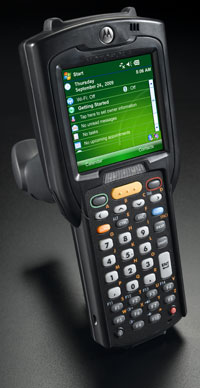On November 3rd, 2009, Motorola introduced the MC3100 Series of handheld mobile computers as an updated next-gen version of its very popular MC3000 Series. Having sold over 750,000 MC3000 units over the past four years, there was no need to change the form factor of this versatile mid-range handheld computer. Instead, Motorola concentrated on technology updates and enhancements that leverage the inherent, field-proven usefulness of this device and also add some interesting new capabilities.

So what's new? First, the MC3100 is faster. Motorola's midrange platform is now built around the 624MHz version of the Marvell PXA320 chip. This is the most powerful of all XScale processors (Marvell makes a faster 806MHz clockspeed version; it's used in the Motorola MC9500) while also being more power-efficient than its predecessors (including the PXA270 used in the older MC3000). Second, the unit now includes an accelerometer for motion-based applications. And third, there is a slew of assorted updates, upgrades and enhancements that represent four additional years of technological progress and experience since the advent of the MC3100's predecessor which scored the coveted Pen Computing Magazine Editor's Choice Award in 2005.
What hasn't changed is the basic form factor. This means that all MC3000 Series peripherals and accessories work with the new MC3100, a big plus for MC3000 customers. What also hasn't changed is the somewhat unique square 320 x 320 pixel touch screen that measures 3.0 inches diagonally. And as before, customers can select from three different keypads (28-key numeric, 38-key shifted alpha, and 48-key alpha-numeric) and also three different physical configurations (standard "straight shooter" imager or laser, rotating gun rurret laser, and pistol grip verions).
On the OS side, depending on the intended application, customers can choose between friendly Windows Mobile 6.X and the more programming-oriented Windows CE 6.0. For application development there is the Motorola Enterprise Mobility developer kit.
On the battery side, a slightly more powerful "smart" Li-Ion packs a massive 18 watt-hours and also includes information indicators on the battery itself that show remaining charge and overall battery health, i.e. if the battery is healthy enough to hold a full charge and last a full shift.
For data capture and scanning, the MC3100 can be equipped with a 1D SE950 laser scanner, or one of the two versions of the 2D SE4500-SR imager with 752 x 480 pixel sensor resolution and an aiming LED/laser.
The unit also includes an integrated UHF RFID tag so it can be located and tracked.
On the wireless side, the MC3100 comes with 802.11a/b/g WiFi with VoIP support, and Bluetooth v2.1 with enhanced data rate. No IrDA (less and less need for it) and no 3G WWAN (that's not what the MC3100 is designed for).
In terms of size and weight, the standard MC3100 with an integrated scanner is 7.5 inches long, 3.2 inches wide, and a maximum of under two inches thick. It weighs just under a pound. The turret laser and pistol grip versions are a bit bulkier.
The MC3100 is a rugged device that can survive multiple 4-foot drops, survived 500 tumbles from about two feet, and it can operate within an extremely wide temperature range of -4 to 122 degrees Fahrenheit. The device carries an IP54 ingress protection rating, which means it is protected against dust and also against water spray from all directions. In our conversation with Sheldon Safir, Director of Marketing for Moto's Enterprise Mobility Solutions Division, he also mentioned the use of more break-resistant glass and more durable polycarbonate keypad inserts.
The unit also carries FIPS 140-2 certification, which addresses US Federal requirements where cryptographic type of security systems will be used.
The accelerometer, what Motorola calls "Enterprise-class Interactive Sensor Technology," enables all sorts of motion-based applications, including dynamic screen orientation (useful when dealing with customers), things like automatic logging of drops, or even power savings (device turns off when no motion is sensed for a period of time).
Overall, the MC3100 represents a well-executed update and enhancement of the company's best-selling MC3000 platform (which will remain available through 2010 or so). Able to use all of the MC3000 family's accessories and peripherals, the MC3100 now offers state-of-the-art processing, communication and data capture technology as well as useful additions like the accelerometer. The MC3100 also excels in ergonomics with its replaceable keypads, and in backroom functionality with its wealth of modular mounting, charging and expansion accessories.
How does the MC3100 compare to Motorola's recently introduced MC9500? Well, that one is a top-of-the-line ultra-rugged model that's also a bit larger and heavier, and offers WWAN and full VGA screen resolution. The MC3100 is more of a mid-range device that is smaller, weighs less, and is designed primarily for retail and similar applications that do not require the same degree of ruggedness and sealing. The MC3100 also costs quite a bit less (US$1295-1,995 vs. US$2,495-3,295)



